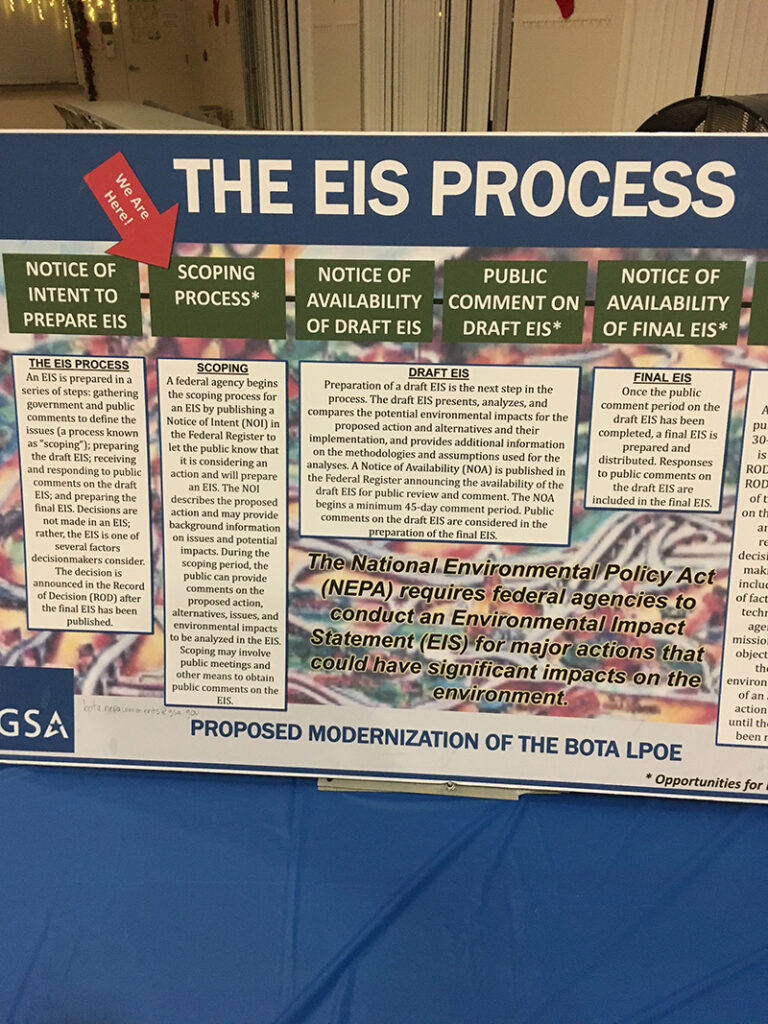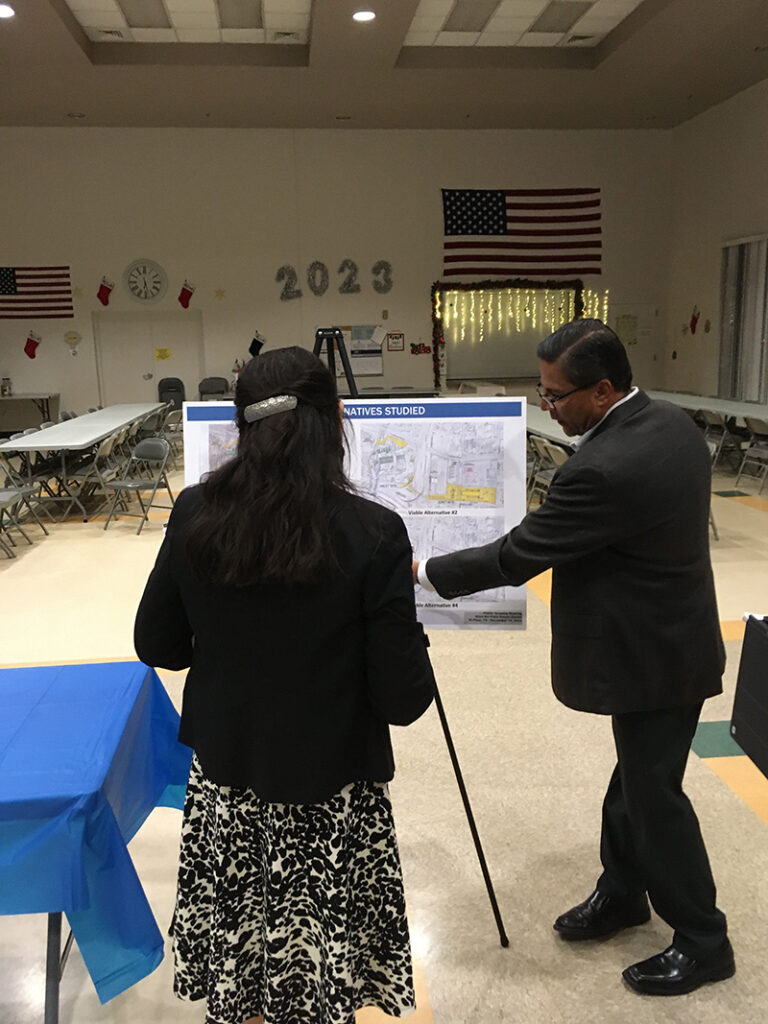By Kent Paterson
Long known as the Sun City, perhaps El Paso will soon be monikered the Semi City, and January’s iconic Sun Bowl, the Semi Bowl. That’s one possible rebranding conjured up by the 24-7 parade of thousands of commercial cargo trucks that roar up and down Interstate 10 and other local highways, many of them going to and from the mainly foreign-owned factories in Mexico, or maquiladoras, whose assembly lines grind away day and night to meet an insatiable U.S. consumer demand.
Commercial truck traffic is a hot topic in the borderland, as was once again attested at a recent public meeting on the pending makeover of the 28-acre Bridge of Americas Land Port of Entry (LPOE).
Hosted by the federal government’s General Services Administration (GSA), the December 13 public scoping meeting marked the formal process of drafting an Environmental Impact Statement (EIS) mandated by the National Environmental Policy Act.
Carrying an estimated price tag of $650-700 million, the modernization of the 56-year-old Bridge of Americas LPOE is considered the largest project funded by the much-touted Bipartisan Infrastructure Law signed by President Biden in 2021.
As spelled out in the Federal Register of November 13, 2023, the purpose of the project is to bring the land port in line with current U.S. Customs and Border Protection operational and safety standards.
Following a protest staged by neighborhood residents opposed to the addition of commercial truck lanes to the LPOE, dozens of community members settled into the Hilos de Plata Community Center in south-central El Paso. There, aided by big maps, Karla Carmichael, GSA NEPA program manager, sketched out alternative LPOE designs government officials identified through an enhanced feasibility study that concluded this year, including a no action alternative.
“I’m not a decision maker. I’m the person who prepares the EIS,” Carmichael explained. The federal official said public comments gathered at the meeting and over the next few weeks will be incorporated into the final EIS. “And you know, your voice matters,” Carmichael assured the audience.
Hilda Villegas of the community organization Familias Unidas del Chamizal told this reporter that her group wasn’t opposed to the upgrade of the Bridge of Americas per se, but opposes nearly all the design alternatives since they include more lanes for commercial truck traffic coming from the Ciudad Juárez maquiladora industry.
“Right now there’s a once in a lifetime investment that none of us will ever see again, and they’re using it to develop pretty much the infrastructure of the maquila industry in Juárez instead of considering the health impact that traffic will have in the lives of our children,” Villegas said.
A map distributed by Familias Unidas del Chamizal at the meeting reveals why the community organization is against commercial truck traffic on the Bridge of the Americas. The map pinpoints existing multiple and cumulative sources of air pollution from trucks, trains, buses, and recycling businesses. Residents are especially concerned about the diesel-fueled trucks that pass by Zavala Elementary School.
Familias Unidas de Chamizal supports the continuation of the no-fee pedestrian and passenger traffic that makes the Bridge of the Americas the favored border crossing of many Paseños and Juarenses. Other citizen groups speaking out against more commercial traffic on the bridge include the Sierra Club and La Mujer Obrera.
Villegas and other community members in attendance were not pleased with Carmichael’s response to a question of whether the EIS would contemplate health impacts. “General Services Administration isn’t equipped to conduct a health survey,” Carmichael said, later adding that other environmental issues such as hazardous materials and environmental justice would be analyzed for the EIS document.
After hearing Carmichael’s statement on health studies, Villegas slammed the GSA process as a “sham,” urging the intervention of the Environmental Protection Agency in the matter.
Since last April, U.S. federal agencies are subject to President Biden’s Executive Order on Revitalizing Our Nation’s Commitment to Environmental Justice for All. The order reads in part that federal agencies shall “consider measures to address and prevent disproportionate and adverse environmental and health impacts on communities, including the cumulative impacts of pollution and other burdens like climate change.”
THE BIGGER PICTURE
Texas Rio Grande Legal Aid Attorney Veronica Carbajal, who represents residents of the Chamizal and San Xavier neighborhoods, attended the December 13 meeting. Carbajal said the potential impacts of the Bridge of the Americas LPOE redo must be analyzed in relation to the Texas Department of Transportation’s 1-10 expansion and 1-10 Connect projects, the latter of which so far has “produced a lot of idling heading south into Mexico, primarily semis.”
Continued Carbajal, “We already saw what TxDOT did to our community. They also said adding more lanes would create a more efficient crossing, and yet we see that horrific situation that plays out every day right there next to our community, next to our schools.”
On that front, Carbajal said TRLA has filed an administrative complaint against TxDOT with the Federal Highway Administration. Countering TxDOT’s claims that I-10 Connect would result in a faster traffic flow, Carbajal said the Texas state agency didn’t consider two important factors: the outcome of moving truck traffic from Paisano Drive onto the freeway, and TxDOT’s lack of control over U.S. and Mexican customs, whose policies and actions influence traffic flows.
According to Carbajal:
“Every El Pasoan knows that part of whether it is 1-10 east or west or US 54 is congested by semis throughout the day. And my clients will tell me that we hear truck drivers honking in the middle of the night. You see semis idling next to Zavala, which is now even closer to the highway than it was before the project began.
And I don’t know where the EPISD trustees were in that. How could they have allowed the highway to move closer to their children… and then do not even comment against the continued use of that freeway for semis? That to me, I don’t understand.”
A look through a partial, numerical lens of commercial truck traffic might give readers outside the borderland a hint of contemporary life on El Paso’s roads. For Fiscal Year 2022 alone, U.S. Customs and Border Protection (CBP), reports their inspectors processed 650,000 cargo trucks at the Zaragoza-Ysleta Port of Entry and 183,743 trucks at the Bridge of Americas LPOE.
The numbers don’t include other local ports of entry at the new but still barely used facility of Tornillo southeast of El Paso and at the busy gates of Santa Teresa in neighboring New Mexico, where crossing trucks then proceed through or skirt El Paso. Of course, the CBP’s stats don’t count the domestic origin commercial trucks that burn rubber on local highway, too.
Quantifying the never-ending accidents, near collisions, stalled, overturned or airborne big rigs, and spilled substances on El Paso area highways is beyond the scope of this article, but suffice it to say that a trip down the lanes of El Chuco might well bring back a famous ACDC song.
Also interviewed immediately after the public meeting, GSA Regional Project Manager Daniel Partida outlined the alternative options for a new LPOE, the NEPA/EIS process, the construction timeline, and the plan to hold more public meetings.
While not directly commenting on health impact concerns, Partida noted criticisms heard by the GSA at earlier, pre-NEPA/EIS community engagement meetings, including the possible demolition of the El Paso County Coliseum.
“This meeting here today is just the start of the NEPA process, which we now begin the public comment for record. All these comments we receive will be pretty much the same comments we receive at the previous meetings,” Partida said. “We will then again engage in the various points of EIS, which will look at air quality, traffic analysis. We’ll also look at the capacities of the facilities and the historic nature of the surroundings.”
Partida said the preferred EIS alternative will “mitigate many of the issues we have out here.” He expects that document will be ready in October 2024, followed by the selection of the design/build contractor possibly in early 2025.
Partida projected that the GSA’s “accelerated” schedule could see construction commence in 2026 and finish in 2029. The Congressional funding, he stressed, needs to allocated by a September 2026 deadline or the money disappears.
Added Partida, “There’s also a no-build (alternative) which we really don’t want to go there, but that is still a possibility. We’d lose out on all the funding and that’s something we don’t really want to even consider but again, it has to be looked at in the NEPA/EIS process.”
For both Villlegas and Carbajal, community health, cumulative pollution effects and reversing environmental injustice must take center stage in the Bridge of Americas LPOE project.
The communities of south-central El Paso were “designed” in the eras of white supremacy and Jim Crow, Carbajal said, and were further negatively affected by the North American Free Trade Agreement and its corollary traffic that plopped the “weight of international commerce” smack dab “on the backs of working class communities” in south-central El Paso.
“This is an opportunity to remedy the environmental racism from previous years,” Carbajal contended. “If it isn’t done and the voice of the people isn’t heard and they continue using this bridge for commercial interests, we are replicating the environmental racism from before once again.”
According to the GSA’s project website, interested persons have until January 16 to submit written comments relevant to the public scoping meeting. For more information:




Some of us have been saying for years that what is needed is not to enlarge the existing bridges, but to construct new bridges, farther out. IMHO, it was also be a boon to El Paso to simply open the International borders within the City Limits (and get the Mexican government to do the same on their side of the border), and force the truck traffic out farther, with CBP checkpoints along all the major thoroughfares out of the area.